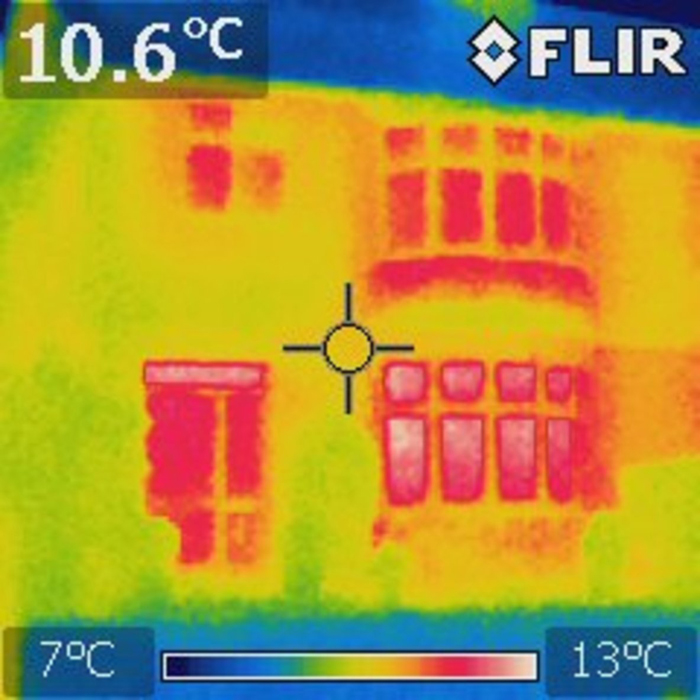
5 Ways to Keep Your Home Warm This Winter

This article was originally published on The Conversation. The publication contributed this article to Live Science's Expert Voices: Op-Ed & Insights.
If you live in a poorly insulated home, and many of us do, you could spend thousands this winter on energy bills. But our ancestors had many ways to keep snug at little or no cost. Now, thanks to modern infrared cameras and advances in environmental physics, we can understand how these methods work and measure how effective they are.
The key to understanding how to keep warm is the fact you lose more heat by radiation to your surroundings than you do by convection to the air. This is why your house feels so cold when you get back from a winter break, even after you’ve turned on the central heating; though the air quickly warms up, the walls take far longer to do so and may continue to make you shiver for up to a day.

In the same way, in poorly insulated houses the inside of the external walls can be several degrees colder than the air and the internal walls, making you feel chilly.
Fortunately, there are five simple ways to overcome this and minimise your energy bills.
Close your curtains at night
During the day, your windows let in more radiant energy than gets out; sunlight can enter through the glass, but the window is opaque to the infrared radiation trying to escape. At night, however, single-glazed windows can get extremely cold – in my Victorian house which we try and keep at a room temperature of 20°C, an infrared camera showed internal window temperatures of as low as 7°C on a frosty night.

Even double-glazed windows aren’t great insulators and can fall to around 14°C. This results in energy losses of 50-100 watts per square metre, equivalent to running an old-fashioned light bulb.
Sign up for the Live Science daily newsletter now
Get the world’s most fascinating discoveries delivered straight to your inbox.
The best way to prevent this heat loss is to close your curtains and lower your blinds immediately after dusk. They provide an extra barrier to radiant heat loss, add insulation and reduce draughts. My cheap blinds raise the internal surface temperature to 16°C and thick curtains raise it virtually to room temperature, minimising heat loss and making the room feel cosier.
Cover your walls
Solid brick or stone walls are better insulators than glass, but they still get cold and let out lots of heat. In my house the external walls fell to 16-17°C, 3-4°C cooler than the air in the room, even though they were made of 50cm thick sandstone.

Fortunately you can significantly reduce energy losses by covering them with picture or mirrors. Even a simple poster adds an extra layer of insulting air, raising internal surface temperatures by around 1°C and cutting lost energy by a quarter. Framed pictures or mirrors are better, if more expensive. Not being a Russian oligarch or a medieval baron I don’t have any carpets or tapestries to hang on my walls, but these would be even more effective.

Best of all are bookshelves. My partner is an avid collector and her old books make superb insulators. The spines of the volumes in our book-lined study are raised almost to room temperature, making it snug and warm. Thermally at least, printed books are far superior to their electronic counterparts.
Cover your front door
Doors can let in draughts, and being thin and sometimes glazed can be very poor insulators, falling to 10-15°C on cold nights. Covering your door and the surrounding wall with a thick lined door curtain can eliminate pretty much all the heat loss.
Use screens
Even if you can’t reduce all the heat loss from your outer walls you can still shield yourself from the cold. Our ancestors used to draw up wooden screens behind themselves and huddle up to the fire. Being at room temperature, the screens kept their backs warm, while radiation from the fire heated up their front. You could do the same, and you could even protect your face from the damaging effects of a roaring fire by using miniature fire screens, just like Georgian ladies.
Position your furniture in the warm
How warm you feel in a room depends on where you are, even though air temperature is the same throughout. You will feel warmer if you position yourself closer to the inside of the house because the cold external walls are further away. So try and place your furniture next to an internal wall.
If your desk is up against an external wall so you can look out of the window your legs will tend to get cold, though you can reduce this effect by leaning a cardboard sheet against the wall. If the head of your bed is next to a cold external wall you will be prone to getting a stiff neck, though you can counter this somewhat by using a solid headboard. The best solution, of course, is a four-poster bed, but most bedrooms just aren’t big enough.
So knowing something about how heat moves can help you brave the cold winter. My experience has also shown that investigating the thermal properties of your house with an infrared camera will keep your kids amused for hours.
Roland Ennos does not work for, consult to, own shares in or receive funding from any company or organisation that would benefit from this article, and has no relevant affiliations.
This article was originally published on The Conversation. Read the original article. Follow all of the Expert Voices issues and debates — and become part of the discussion — on Facebook, Twitter and Google +. The views expressed are those of the author and do not necessarily reflect the views of the publisher. This version of the article was originally published on Live Science.
Science news this week: Controversy around the dire wolf 'de-extinctions' and a 3D hologram breakthrough
Scientists built largest brain 'connectome' to date by having a lab mouse watch 'The Matrix' and 'Star Wars'
Archaeologists may have discovered the birthplace of Alexander the Great's grandmother










